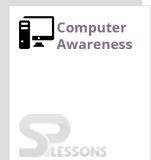 Introduction
Introduction
The computer as we know it today had its beginning with a 19th century English mathematics professor name Charles Babbage. He designed the Analytical Engine and it was this design that the basic framework of the computers of today are based on. Below are the detail History of Computers.
 Concepts
Concepts
History of Computers:
There are five generations of computer till today. In the early 1820s “Charles Babbage” designed a computing machine called the Difference Engine. It is used in calculating the simple math tables. In the 1830s he designed a second computing machine called the Analytical Engine. This machine is used in calculating complicated problems by following a set of instructions.
Generations of computer:
Types Of Computers:
On the basis of its functionality, size, speed and cost computers can be divided into three types.
| Generations | Period | Technology |
|---|---|---|
| Early Period | 1000 BC - 1940 | Many as described above |
| First Generations | 1940 - 1956 | Vacuum Tubes |
| Second Generations | 1956 - 1963 | Transistors |
| Third Generation | 1964 - 1971 | Integrated Circuits (ICs) |
| Fourth Generations | 1972 - 2010 | Microprocessor/Very Large Scale integration |
| Fifth Generation | 2010 - till today | ULSI Microprocessor and Artificial intelligence |
- Analog
- Digital
- Hybrid
 Questions
Questions
1. Main component of first generation computer was ___________.
- Transistors
- Vacuum Tubes
- Integrated Circuits
- Microprocessor
- 1949-1955
- 1955-1975
- 1965-1970
- 1956-1965
- First Generation
- Second Generation
- Third Generation
- Fourth Generation
- Very Large Storage Integration
- Very Large Storage Integrator
- Very Large Scale Integration
- Very Low Storage Integrator
- FORTRAN
- COBOL
- BASIC
- Java
- Analog Computer
- Digital Computer
- Hybrid Computer
- Mainframe Computer
- Analytical Engine
- Difference Engine
- Colossus
- ABACUS
- COBOL
- PASCAL
- BASIC
- FORTRAN
- Basic Input Output System
- Best Input Output System
- Basic Input Output Symbol
- Base Input Output Symbol
- Personal computer
- Midrange computers
- Laptop
- Monitor
- Hard Disk
- Pen Drive
- DVD Disks
- Blue-Ray Disks
- Hard Disk
- Magnet Disks
- Compact Disks
- Magnetic Tapes
- Mainframe Computers
- Maini Computers
- Micro Computers
- Super Computers
- 680 KB
- 680 Bytes
- 680 MB
- 680 GB
- First Generation
- Second Generation
- Third Generation
- Fourth Generation
- Silicon
- Copper
- Gold
- Platinum
- Pen drives
- Disks
- RAM
- ROM
- Input unit
- Secondary Unit
- Hard disk
- Primary Memory Unit
- Problem Oriented Language
- Business Oriented Language
- Business Oriented Language
- All of the above
- Mechanical
- Electrical
- Electro Magnetic
- Laser
- Multiple
- Single
- Both A and B
- None of the above
- Ultra Large Storage Integration
- Ultra Large Scale Integration
- Ultra Large Scale Integrator
- Ultra Large Storage Integrator
- DUV
- CCTV
- VDU
- UVD
- Read only memory
- Read /write memory
- Write only memory
- None of these
- 1.40 MB
- 1.44 MB
- 1.40 MB
- 1.44 GB



